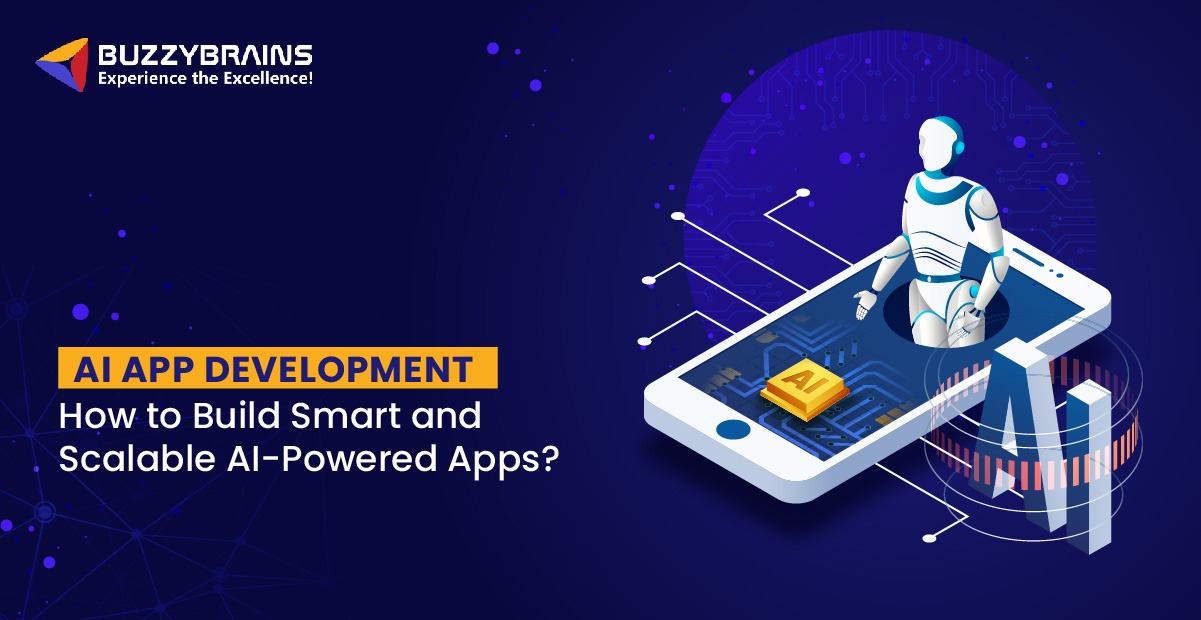AI App Development: How to Build Smart and Scalable AI-Powered Apps?

Artificial Intelligence (AI) is transforming how applications function. From personalized recommendations to automated customer service, AI-powered apps are enhancing user experiences and business efficiency.
Developing an AI-powered app requires careful planning, the right tools, and a clear understanding of AI technologies. In this guide, we will explore how to build smart and scalable AI apps from scratch.
- What Is AI-Powered Apps?
- What is AI App Development?
- Key Benefits of AI-Powered Apps
- How to Build Smart and Scalable AI-Powered Apps?
- Challenges in AI App Development
- Real-World Examples of AI-Powered Apps
- Future Trends in AI App Development
- FAQs About AI-Powered Apps
- Conclusion
- Looking to Build an AI-Powered App? Let BuzzyBrains Help!
What Is AI-Powered Apps?
AI-powered apps use artificial intelligence to analyze data, automate tasks, and provide intelligent responses. These applications leverage machine learning (ML), natural language processing (NLP), and computer vision to improve performance and accuracy.
Many industries use AI apps to enhance productivity. Examples include virtual assistants like Siri, AI-driven chatbots, recommendation engines in e-commerce, and fraud detection systems in banking.
What is AI App Development?
AI app development refers to integrating artificial intelligence into mobile or web applications. This process involves data collection, model training, and implementing AI algorithms to perform specific tasks.
Developers use AI frameworks like TensorFlow, PyTorch, and OpenAI’s GPT to build intelligent applications. Cloud platforms like AWS AI, Google Cloud AI, and Microsoft Azure AI provide tools for scalable AI model deployment.
AI app development is growing rapidly. According to a report by MarketsandMarkets, the AI software market is expected grow from $214.6 billion in 2024 to reach $1339.1 billion by 2020. Businesses are increasingly investing in AI-driven solutions to improve efficiency and customer engagement.
Key Benefits of AI-Powered Apps
AI-powered apps offer several advantages for businesses and users:
- Enhanced User Experience – AI personalizes interactions, providing tailored recommendations.
- Automation and Efficiency – Reduces manual tasks and speeds up processes.
- Data-Driven Decision Making – AI analyzes large data sets for valuable insights.
- Improved Customer Support – AI chatbots handle inquiries 24/7, improving response time.
- Fraud Detection and Security – AI identifies suspicious activities and prevents fraud.
- Scalability – AI apps grow with business demands, handling more users efficiently.
How to Build Smart and Scalable AI-Powered Apps?
Developing AI-powered apps requires a structured approach. It involves multiple stages, from defining objectives to deploying scalable AI models. Below is a step-by-step guide to building an AI-powered app.
1. Define the Purpose and Use Case
Before starting AI app development, it’s essential to determine the specific problem AI will solve. Identify the core objective of integrating AI into your application.
Key Considerations:
- Target Audience: Who will use the app? What are their needs?
- AI Capabilities: What AI functions are required? Examples include chatbots, image recognition, recommendation systems, and fraud detection.
- Business Goals: Will AI improve efficiency, reduce costs, or enhance customer engagement?
Example: If developing an AI chatbot for customer support, the goal might be to automate responses, reduce wait times, and handle FAQs efficiently.
2. Choose the Right AI Technology and Tools
AI development requires selecting the right technology stack. Depending on your app’s requirements, you will need various AI frameworks, programming languages, and cloud services.
Popular AI Frameworks:
- TensorFlow – Open-source machine learning library for deep learning models.
- PyTorch – Flexible deep learning framework for research and production.
- Scikit-learn – Useful for traditional machine learning algorithms like regression and classification.
- OpenAI GPT – Best for natural language processing (NLP) applications.
Cloud AI Services:
- Google Cloud AI – Offers AI models for vision, speech, and natural language processing.
- AWS AI & ML – Provides machine learning tools like Amazon SageMaker.
- Microsoft Azure AI – Cloud-based AI models for businesses.
NLP and Computer Vision Tools:
- Dialogflow & IBM Watson – Used for chatbot development and voice assistants.
- OpenCV & Amazon Rekognition – Used for image and facial recognition.
Example: A healthcare app that detects diseases from X-rays can use TensorFlow for deep learning, AWS AI for cloud processing, and OpenCV for image analysis.
3. Collect and Prepare Data
AI models require high-quality data for training. The accuracy of an AI app depends on the data it learns from.
Data Collection Sources:
- User Data: Information collected from app interactions.
- Public Datasets: Kaggle, UCI Machine Learning Repository, and Google Dataset Search.
- APIs: External services providing AI-ready data.
Data Preprocessing Steps:
- Cleaning: Remove duplicate, incomplete, or irrelevant data.
- Normalization: Convert data into a standardized format.
- Labeling: For supervised learning models, datasets need labeled inputs.
Example: An AI-powered e-commerce app uses customer browsing history and past purchases to train its recommendation engine.
4. Develop and Train AI Models
Once data is collected and pre-processed, it’s time to train AI models. The choice of model depends on the use case.
Types of AI Models:
- Supervised Learning: Uses labeled data (e.g., fraud detection in banking).
- Unsupervised Learning: Finds hidden patterns in data (e.g., customer segmentation).
- Reinforcement Learning: Models learn through trial and error (e.g., self-driving cars).
Model Training Process:
- Select an Algorithm: Choose machine learning models like decision trees, neural networks, or support vector machines.
- Train the Model: Feed the model with historical data and adjust weights to optimize accuracy.
- Evaluate Performance: Use metrics like precision, recall, and F1 score.
Example: A financial AI app predicts stock trends using supervised learning on past market data.
5. Build the App Architecture
An AI-powered app consists of multiple components, including backend servers, AI models, and front-end interfaces.
Key Components:
- Frontend (User Interface): Designed using React, Angular, or Flutter.
- Backend (Server Logic): Built with Node.js, Python (Django/Flask), or Java.
- Database: Stores structured and unstructured data (SQL, NoSQL, Firebase).
- AI Model Integration: Communicates with the backend via APIs.
Example: A voice assistant AI app might use Flutter for the frontend, Python for backend logic, Firebase for storage, and Google Cloud AI for speech recognition.
6. Test and Optimize the AI Model
Testing ensures the AI model works as expected and improves performance.
Testing Methods:
- Unit Testing: Checks individual AI components.
- A/B Testing: Compares different AI models.
- User Testing: Ensures AI predictions match real-world use cases.
Optimization Techniques:
- Hyperparameter Tuning: Adjust model parameters for better accuracy.
- Reduce Overfitting: Avoids the model learning noise instead of patterns.
- Continuous Learning: The AI model improves over time with new data.
Example: A fraud detection AI in a banking app is tested with historical fraudulent transactions to refine accuracy.
7. Deploy the AI Model and Scale
Once the AI model is trained and tested, it’s time for deployment. Scalability is crucial to handle increasing user demand.
Deployment Strategies:
- On-Premises: AI runs on local servers (preferred for high-security apps).
- Cloud-Based: AI hosted on cloud services like AWS, Google Cloud, or Azure.
- Hybrid: A combination of on-premises and cloud deployment.
Scaling Techniques:
- Containerization (Docker, Kubernetes): Helps manage multiple AI models.
- Auto-scaling: Adjusts resources dynamically based on traffic.
- Edge AI: Runs AI models on local devices instead of the cloud for faster processing.
Example: A healthcare AI app deploying on the cloud ensures real-time disease prediction at a global scale.
8. Monitor Performance and Update Regularly
AI models require constant monitoring and updates to maintain performance.
Monitoring Aspects:
- Model Accuracy: AI predictions should remain relevant.
- User Behavior Analysis: Monitor how users interact with AI.
- Feedback Integration: Improve AI based on user suggestions.
Updating the AI Model:
- Re-train with New Data: AI adapts to changing trends.
- Software Updates: Fix bugs and improve UI/UX.
- Security Enhancements: Protect against AI model attacks.
Example: A personalized shopping AI updates its recommendations based on new buying trends.
Challenges in AI App Development
Developing AI-powered apps comes with challenges, including:
- Data Privacy and Security – AI apps must comply with data protection regulations.
- Model Bias and Fairness – Training data should be diverse to prevent biases.
- High Computational Costs – AI model training requires significant computing power.
- User Trust and Adoption – Transparent AI decision-making improves user trust.
- Integration Complexity – AI models must be seamlessly integrated into applications.
Real-World Examples of AI-Powered Apps
1. Google Assistant & Siri
Voice AI assistants use NLP to understand user queries and provide responses and power smart devices, offering hands-free control and automation.
2. Netflix & Spotify
These platforms use AI for personalized content recommendations. Machine learning models analyze user behavior to suggest movies, shows, and music.
3. Tesla Autopilot
Tesla’s self-driving technology relies on AI and deep learning to navigate roads, detect obstacles, and make driving decisions.
4. AI Chatbots in e-commerce
AI-powered chatbots on websites like Amazon and Shopify handle customer inquiries, suggest products, and assist in transactions.
5. Healthcare AI Diagnosis
AI-powered medical apps like IBM Watson Health analyze patient data, detect diseases, and assist doctors in diagnostics.
Future Trends in AI App Development
AI technology is constantly evolving. Here are some trends shaping the future:
- Low-Code/No-Code AI Development – Simplifies AI integration for non-developers.
- Explainable AI (XAI) – Improves transparency and trust in AI decisions.
- Edge AI – Enables real-time processing on devices, reducing latency.
- AI Ethics and Regulations – More focus on responsible AI development.
- AI-Powered Augmented Reality (AR) and Virtual Reality (VR) – Enhances interactive experiences.
Related Blog: Top 10 Latest AI Trends in 2025
FAQs About AI-Powered Apps
Q1. How do AI-powered apps enhance user experience?
AI apps personalize experiences based on user behavior. They offer recommendations, automate tasks, and improve customer support, making interactions seamless.
Q2. What industries can benefit from AI-powered apps?
Industries like healthcare, finance, retail, logistics, and education benefit from AI apps. These apps improve decision-making, automate processes, and enhance customer engagement.
Q3. What is the role of machine learning in AI apps?
Machine learning enables AI apps to learn from data and improve over time. It helps with pattern recognition, automation, and predictive analytics.
Q4. How much does it cost to develop an AI-powered app?
The cost varies based on complexity, features, and AI technology used. A basic AI-powered app may cost between $30,000 and $100,000, while advanced solutions can go beyond $500,000.
Q5. Can AI-powered apps work offline?
Some AI apps can function offline by using pre-trained models. However, real-time AI applications often require an internet connection for cloud-based processing.
Conclusion
AI app development is revolutionizing industries with intelligent automation and data-driven insights. Businesses that integrate AI into their applications gain a competitive edge by enhancing user experiences and efficiency.
Developing an AI-powered app requires careful planning, selecting the right tools, and continuous model optimization. By following the right approach, businesses can create scalable and effective AI applications.
Looking to Build an AI-Powered App? Let BuzzyBrains Help!
At BuzzyBrains, we specialize in AI app development, offering custom solutions for businesses across industries. Our team of AI experts builds scalable and efficient applications tailored to your needs.
Get in touch with us today and take your business to the next level with AI!

